sensor TOYOTA HILUX 2023 Owner's Guide
[x] Cancel search | Manufacturer: TOYOTA, Model Year: 2023, Model line: HILUX, Model: TOYOTA HILUX 2023Pages: 810, PDF Size: 131.54 MB
Page 323 of 810
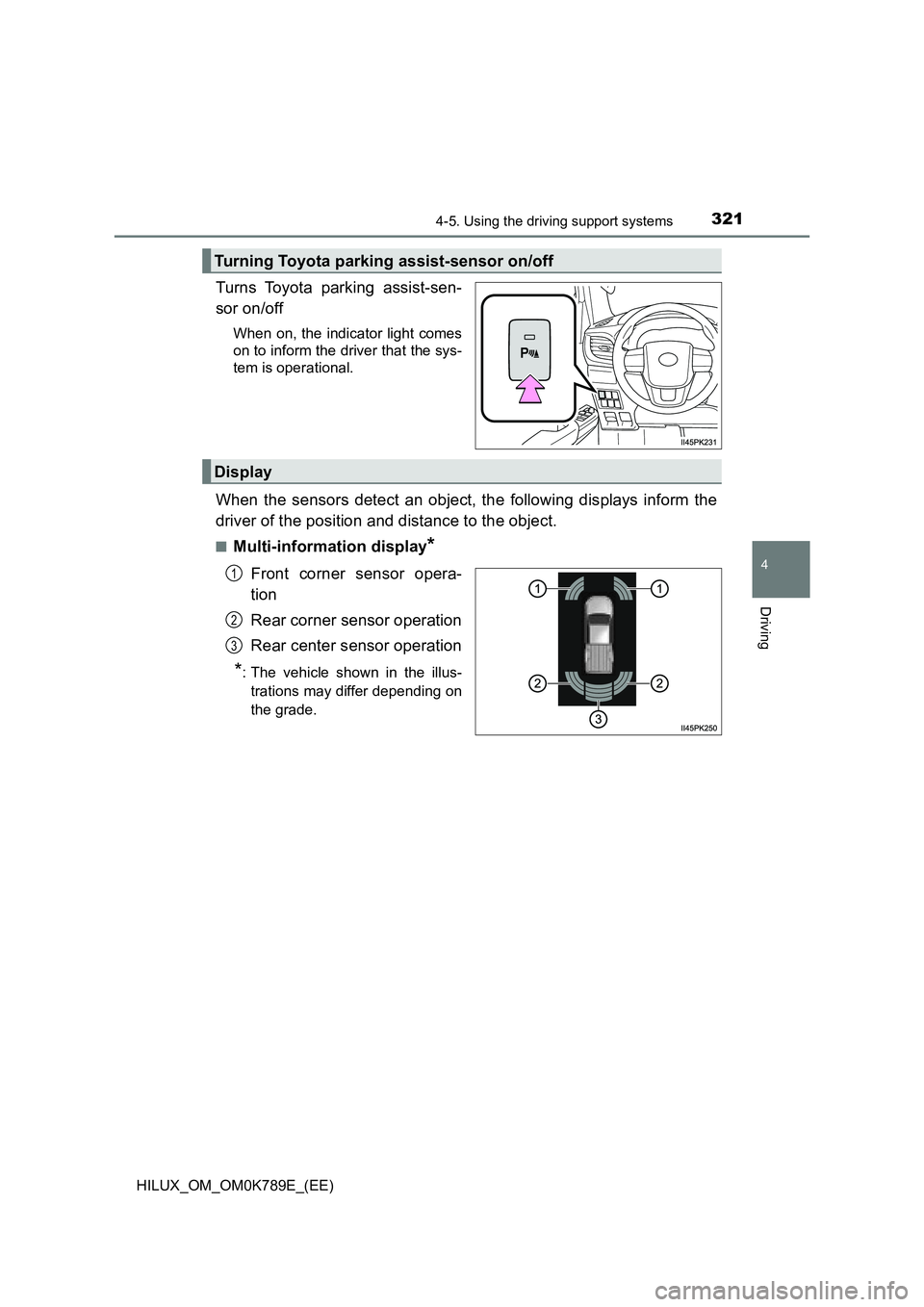
3214-5. Using the driving support systems
4
Driving
HILUX_OM_OM0K789E_(EE)
Turns Toyota parking assist-sen-
sor on/off
When on, the indicator light comes
on to inform the driver that the sys-
tem is operational.
When the sensors detect an object, the following displays inform the
driver of the position and distance to the object.
■Multi-information display*
Front corner sensor opera-
tion
Rear corner sensor operation
Rear center sensor operation
*: The vehicle shown in the illus-
trations may differ depending on
the grade.
Turning Toyota parking assist-sensor on/off
Display
1
2
3
Page 324 of 810

3224-5. Using the driving support systems
HILUX_OM_OM0K789E_(EE)
■Distance display
When an object is detected by a sensor, the approximate distance
to the object will be displayed on the multi-information display.
*: The images may differ from those shown in the illustrations. ( P. 3 2 1 )
Sensor detection display, object distance
Multi-
information
display*
Approximate distance to object
Front corner sensorRear center and
Rear corner sensor
(continuous)
Rear center sensor only:
150 cm (4.9 ft.) to
80 cm (2.6 ft.)
(continuous)
60 cm (2.0 ft.) to
45 cm (1.5 ft.)
Rear center sensor:
80 cm (2.6 ft.) to
70 cm (2.3 ft.)
Rear corner sensor:
60 cm (2.0 ft.) to
50 cm (1.6 ft.)
(continuous)
45 cm (1.5 ft.) to
35 cm (1.1 ft.)
Rear center sensor:
70 cm (2.3 ft.) to
60 cm (2.0 ft.)
Rear corner sensor:
50 cm (1.6 ft.) to
40 cm (1.3 ft.)
(blinking)
Less than 35 cm (1.1 ft.)
Rear center sensor:
Less than 60 cm (2.0 ft.)
Rear corner sensor:
Less than 40 cm (1.3 ft.)
Page 325 of 810
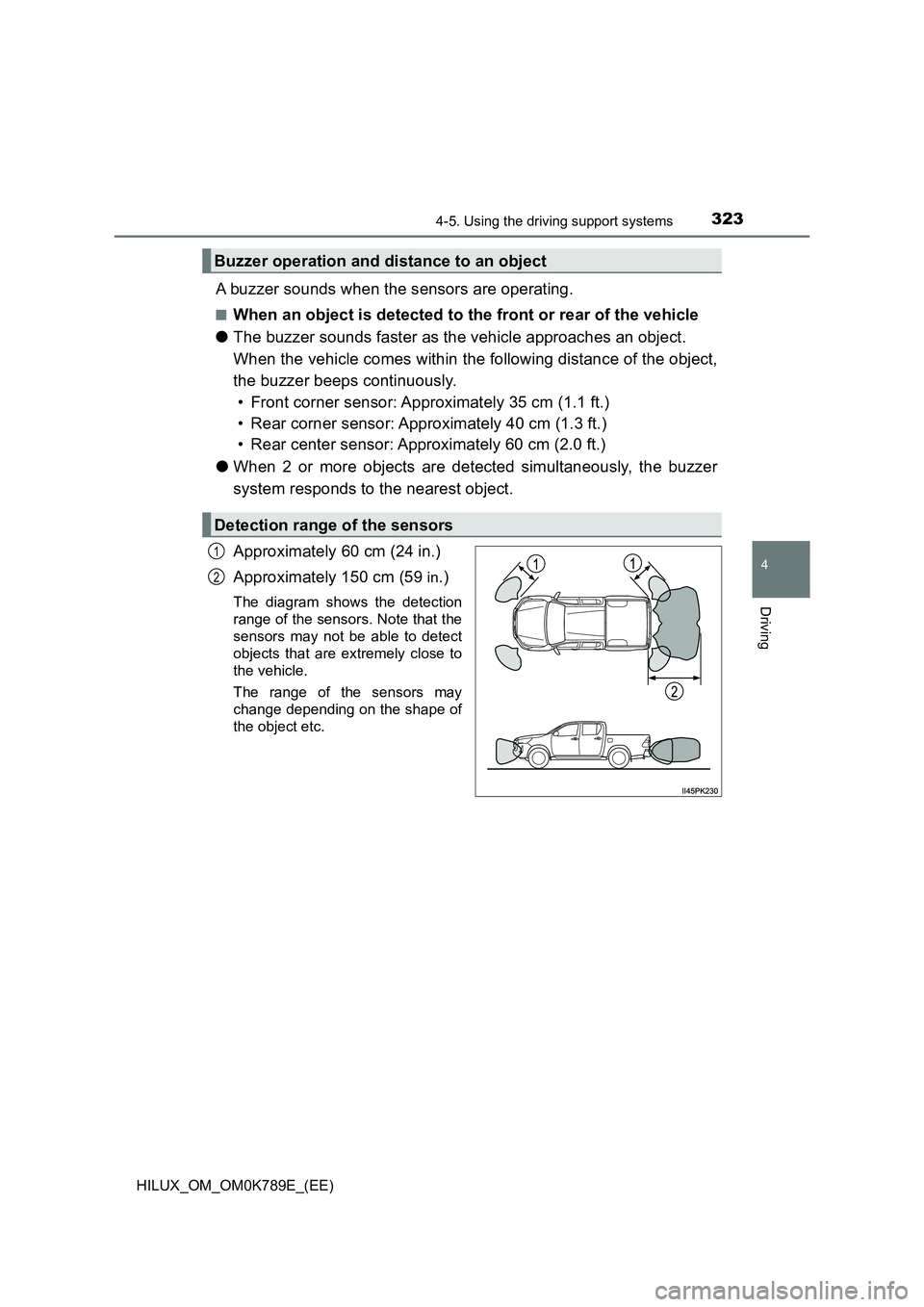
3234-5. Using the driving support systems
4
Driving
HILUX_OM_OM0K789E_(EE)
A buzzer sounds when the sensors are operating.
■When an object is detected to the front or rear of the vehicle
● The buzzer sounds faster as the vehicle approaches an object.
When the vehicle comes within the following distance of the object,
the buzzer beeps continuously.
• Front corner sensor: Approximately 35 cm (1.1 ft.)
• Rear corner sensor: Approximately 40 cm (1.3 ft.)
• Rear center sensor: Approximately 60 cm (2.0 ft.)
● When 2 or more objects are detected simultaneously, the buzzer
system responds to the nearest object.
Approximately 60 cm (24 in.)
Approximately 150 cm (59 in.)
The diagram shows the detection
range of the sensors. Note that the
sensors may not be able to detect
objects that are extremely close to
the vehicle.
The range of the sensors may
change depending on the shape of
the object etc.
Buzzer operation and distance to an object
Detection range of the sensors
1
2
Page 326 of 810

3244-5. Using the driving support systems
HILUX_OM_OM0K789E_(EE)
■Toyota parking assist-sensor can be operated when
● The engine switch is in the “ON” position (vehicles without smart entry &
start system) or IGNITION ON mode (vehicles with smart entry & start sys-
tem).
● Front corner sensor:
• The shift lever is in other than P.
• The vehicle speed is approximately 10 km/h (6 mph) or less.
● Rear corner and rear center sensors:
The shift lever is in R.
■ Sensor detection information
● The sensor’s detection areas are limited to the areas around the vehicle’s
bumper.
● Depending on the shape of the object and other factors, the detection dis-
tance may shorten, or detection may be impossible.
● Detection may be impossible if the objects draw too close to the sensor.
● There will be a short delay between object detection and display. Even at
low speeds, there is a possibility that the object will come within the sensor’s
detection areas before the display is shown and the warning beep sounds.
● Thin posts or objects lower than the sensor may not be detected when
approached, even if they have been detected once.
● It might be difficult to hear the buzzer due to the volume of the audio system
or air flow noise of the air conditioning system.
■ Objects which the system may not properly detect
The shape of the object may prevent the sensor from detecting it. Pay partic-
ular attention to the following objects:
● Wires, fences, ropes, etc.
● Cotton, snow and other materials that absorb sound waves
● Sharply-angled objects
● Low objects
● Tall objects with upper sections projecting outwards in the direction of your
vehicle
● Moving objects such as people or animals
People may not be detected if they are wearing certain types of clothing.
■ Situations in which the system may not operate properly
Certain vehicle conditions and the surrounding environment may affect the
ability of the sensor to correctly detect objects. Particular instances where this
may occur are listed below.
● There is dirt, snow or ice on the sensor. (Wiping the sensors will resolve this
problem.)
Page 327 of 810

3254-5. Using the driving support systems
4
Driving
HILUX_OM_OM0K789E_(EE)
● The sensor is frozen. (Thawing the area will resolve this problem.)
In especially cold weather, if a sensor is frozen, the screen may show an
abnormal display, or objects may not be detected.
● The sensor is covered in any way.
● On an extremely bumpy road, on an incline, on gravel, or on grass
● When vehicle horns, vehicle detectors, motorcycle engines, air brakes of
large vehicles, the clearance sonar of ot her vehicles or other devices which
produce ultrasonic waves are near the vehicle.
● A sensor is coated with a sheet of spray or heavy rain.
● If objects draw too close to the sensor.
● When a pedestrian is wearing clothing that does not reflect ultrasonic waves
(ex. skirts with gathers or frills).
● When objects that are not perpendicular to the ground, not perpendicular to
the vehicle traveling direction, uneven, or waving are in the detection range.
● Strong wind is blowing.
● When driving in inclement weather such as fog, snow or a sandstorm.
● When an object that cannot be detected is between the vehicle and a
detected object.
● If an object such as a vehicle, motorcycle, bicycle or pedestrian cuts in front
of the vehicle or runs out from the side of the vehicle.
● If the orientation of a sensor has been changed due to a collision or other
impact.
● When equipment that may obstruct a sensor is installed, such as a towing
eyelet, bumper protector (an additional trim strip, etc.), bicycle carrier, or
snow plow.
● If the front of the vehicle is raised or lowered due to the carried load.
● If the vehicle cannot be driven in a stable manner, such as when the vehicle
has been in an accident or is malfunctioning.
● When tire chains, a compact spare tire or an emergency tire puncture repair
kit are used.
● When a sensor or the area around a
sensor is extremely hot or cold
Page 328 of 810
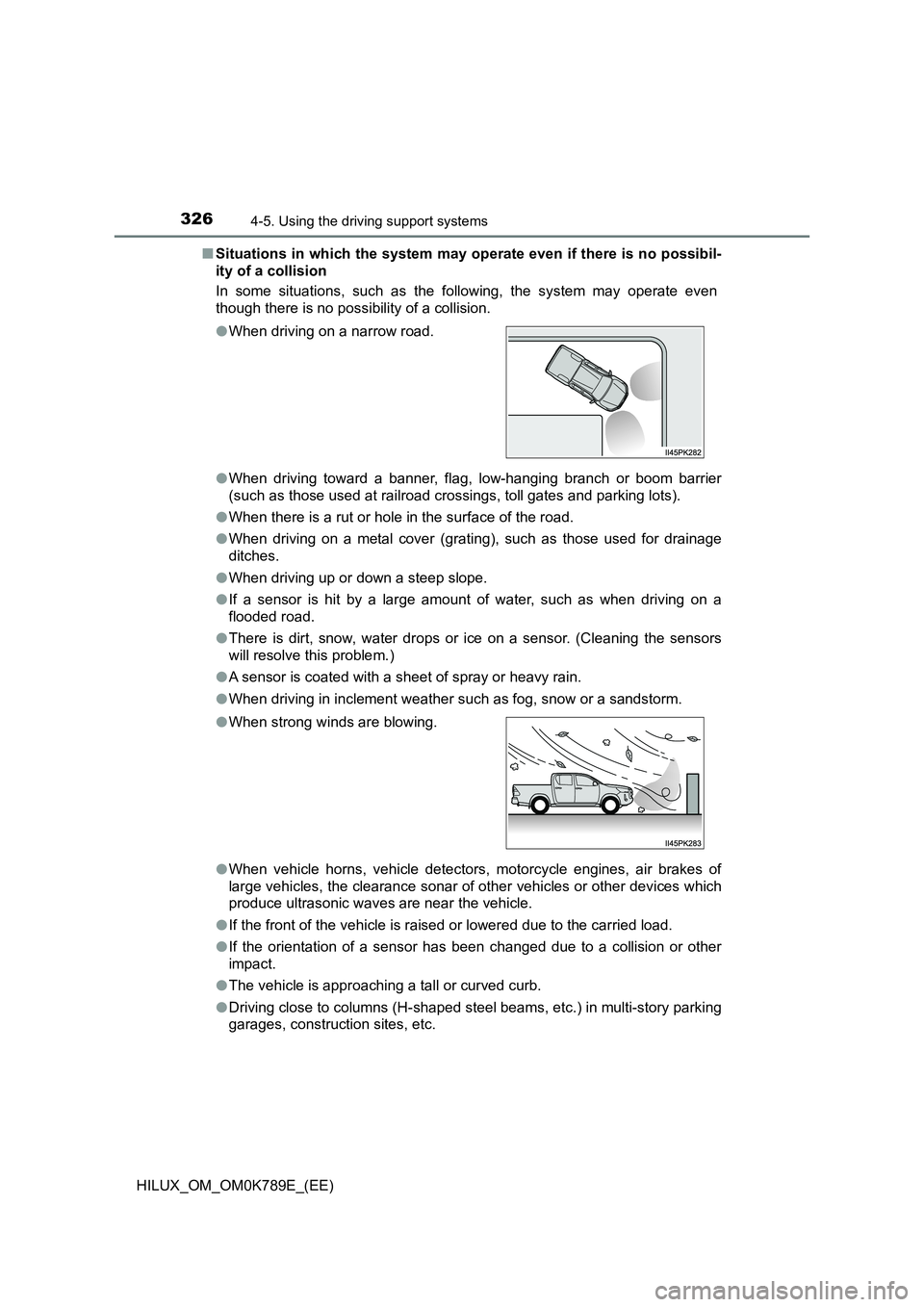
3264-5. Using the driving support systems
HILUX_OM_OM0K789E_(EE)
■ Situations in which the system may operate even if there is no possibil-
ity of a collision
In some situations, such as the following, the system may operate even
though there is no possibility of a collision.
● When driving toward a banner, flag, low-hanging branch or boom barrier
(such as those used at railroad crossings, toll gates and parking lots).
● When there is a rut or hole in the surface of the road.
● When driving on a metal cover (grating), such as those used for drainage
ditches.
● When driving up or down a steep slope.
● If a sensor is hit by a large amount of water, such as when driving on a
flooded road.
● There is dirt, snow, water drops or ice on a sensor. (Cleaning the sensors
will resolve this problem.)
● A sensor is coated with a sheet of spray or heavy rain.
● When driving in inclement weather such as fog, snow or a sandstorm.
● When vehicle horns, vehicle detectors, motorcycle engines, air brakes of
large vehicles, the clearance sonar of ot her vehicles or other devices which
produce ultrasonic waves are near the vehicle.
● If the front of the vehicle is raised or lowered due to the carried load.
● If the orientation of a sensor has been changed due to a collision or other
impact.
● The vehicle is approaching a tall or curved curb.
● Driving close to columns (H-shaped steel beams, etc.) in multi-story parking
garages, construction sites, etc.
● When driving on a narrow road.
● When strong winds are blowing.
Page 329 of 810
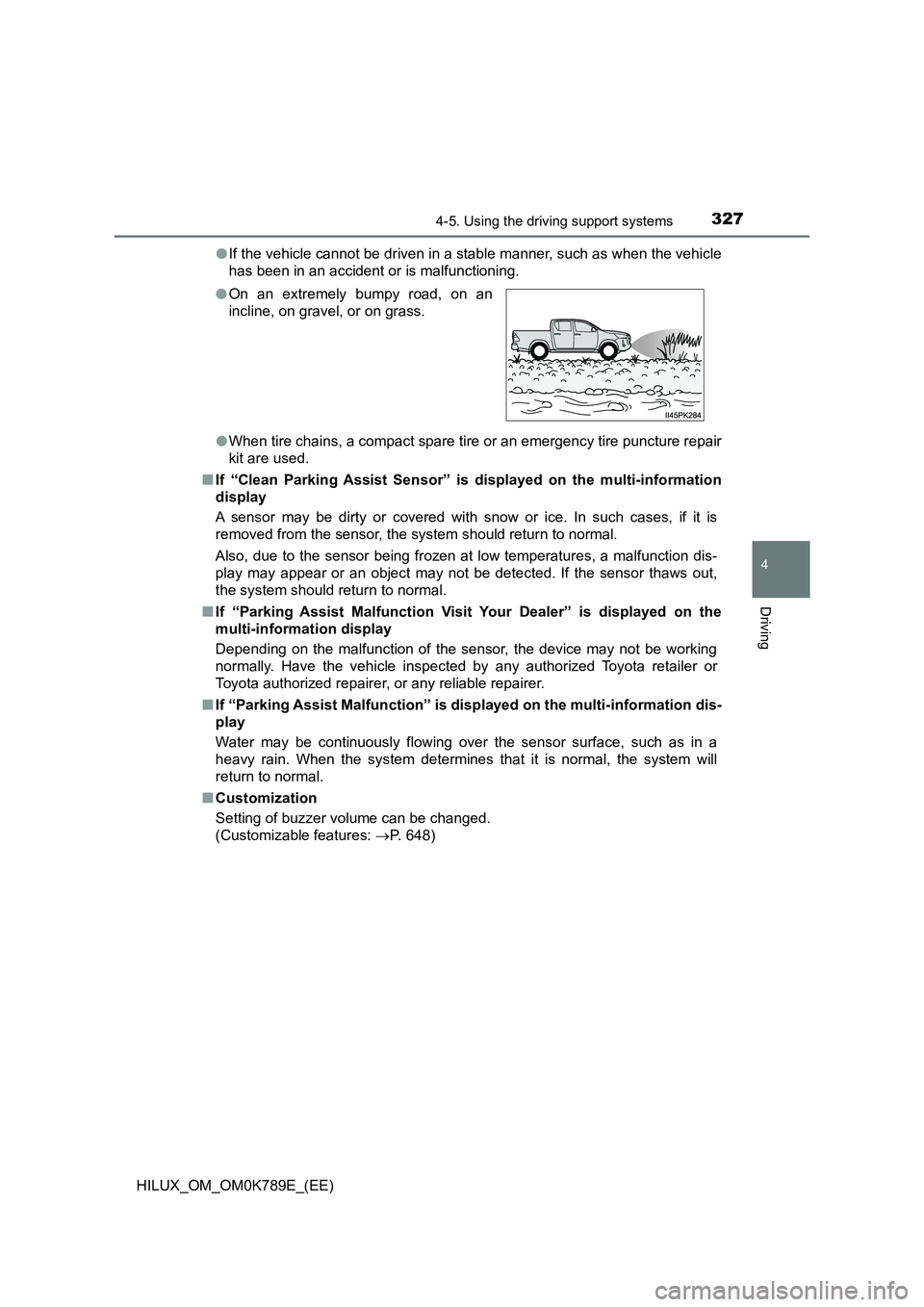
3274-5. Using the driving support systems
4
Driving
HILUX_OM_OM0K789E_(EE)
● If the vehicle cannot be driven in a stable manner, such as when the vehicle
has been in an accident or is malfunctioning.
● When tire chains, a compact spare tire or an emergency tire puncture repair
kit are used.
■ If “Clean Parking Assist Sensor” is displayed on the multi-information
display
A sensor may be dirty or covered with snow or ice. In such cases, if it is
removed from the sensor, the system should return to normal.
Also, due to the sensor being frozen at low temperatures, a malfunction dis-
play may appear or an object may not be detected. If the sensor thaws out,
the system should return to normal.
■ If “Parking Assist Malfunction Visit Your Dealer” is displayed on the
multi-information display
Depending on the malfunction of the sensor, the device may not be working
normally. Have the vehicle inspected by any authorized Toyota retailer or
Toyota authorized repairer, or any reliable repairer.
■ If “Parking Assist Malfunction” is displayed on the multi-information dis-
play
Water may be continuously flowing over the sensor surface, such as in a
heavy rain. When the system determines that it is normal, the system will
return to normal.
■ Customization
Setting of buzzer volume can be changed.
(Customizable features: P. 648)
● On an extremely bumpy road, on an
incline, on gravel, or on grass.
Page 330 of 810
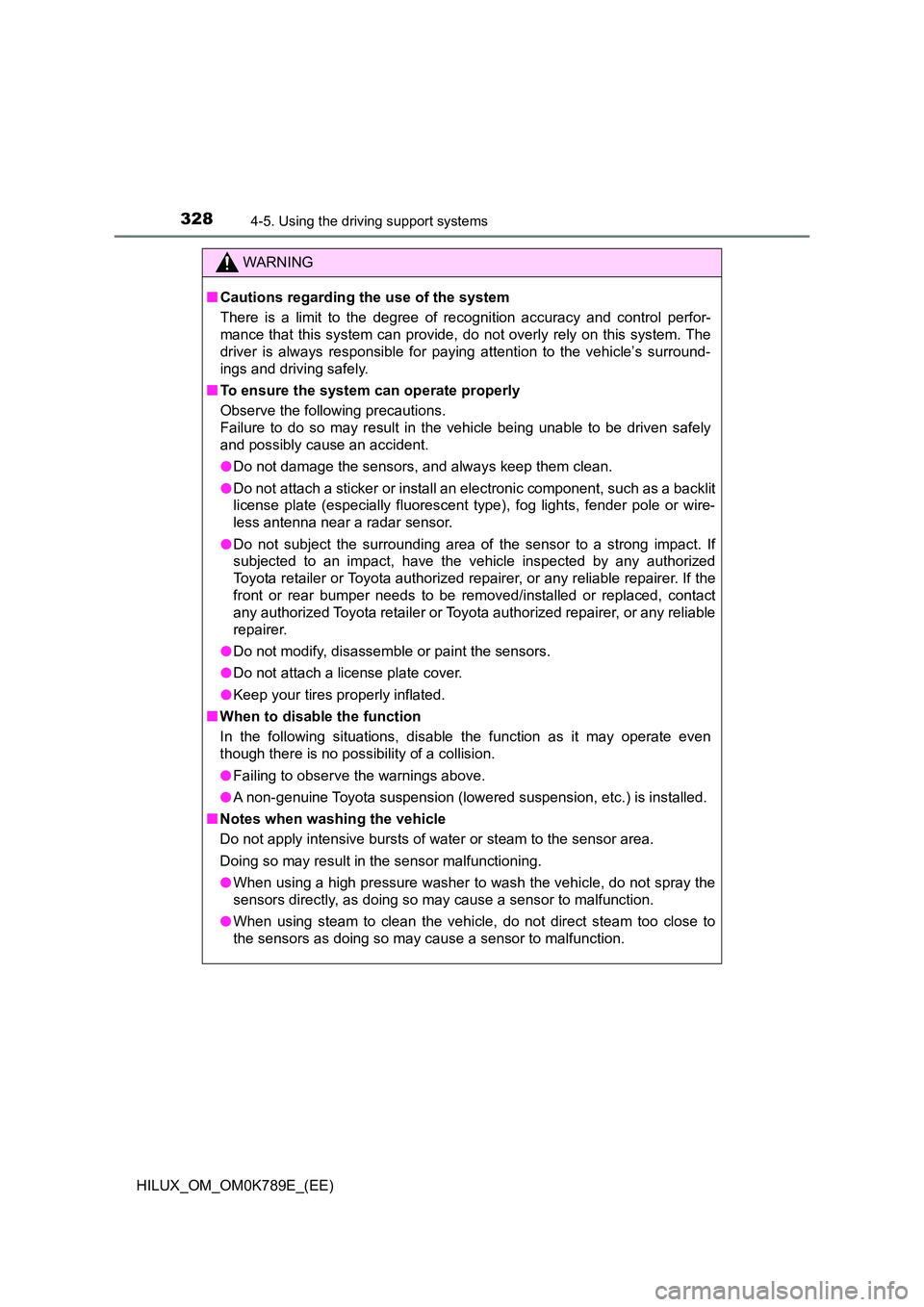
3284-5. Using the driving support systems
HILUX_OM_OM0K789E_(EE)
WARNING
■Cautions regarding the use of the system
There is a limit to the degree of recognition accuracy and control perfor-
mance that this system can provide, do not overly rely on this system. The
driver is always responsible for paying attention to the vehicle’s surround-
ings and driving safely.
■ To ensure the system can operate properly
Observe the following precautions.
Failure to do so may result in the vehicle being unable to be driven safely
and possibly cause an accident.
● Do not damage the sensors, and always keep them clean.
● Do not attach a sticker or install an electronic component, such as a backlit
license plate (especially fluorescent type), fog lights, fender pole or wire-
less antenna near a radar sensor.
● Do not subject the surrounding area of the sensor to a strong impact. If
subjected to an impact, have the vehicle inspected by any authorized
Toyota retailer or Toyota authorized repai rer, or any reliable repairer. If the
front or rear bumper needs to be removed/installed or replaced, contact
any authorized Toyota retailer or Toyota authorized repairer, or any reliable
repairer.
● Do not modify, disassemble or paint the sensors.
● Do not attach a license plate cover.
● Keep your tires properly inflated.
■ When to disable the function
In the following situations, disable the function as it may operate even
though there is no possibility of a collision.
● Failing to observe the warnings above.
● A non-genuine Toyota suspension (lowered suspension, etc.) is installed.
■ Notes when washing the vehicle
Do not apply intensive bursts of water or steam to the sensor area.
Doing so may result in the sensor malfunctioning.
● When using a high pressure washer to wash the vehicle, do not spray the
sensors directly, as doing so may cause a sensor to malfunction.
● When using steam to clean the vehicle, do not direct steam too close to
the sensors as doing so may cause a sensor to malfunction.
Page 331 of 810
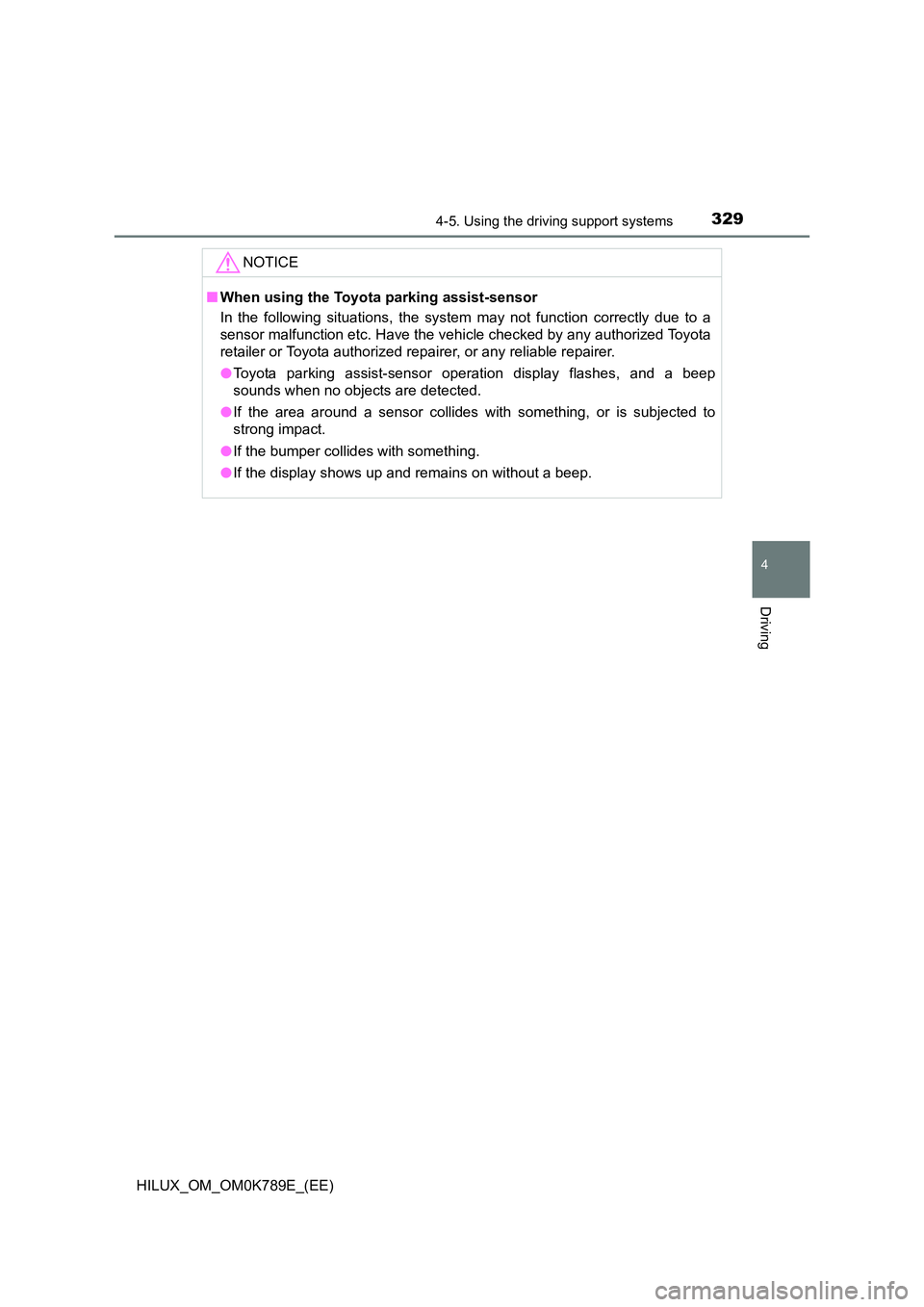
3294-5. Using the driving support systems
4
Driving
HILUX_OM_OM0K789E_(EE)
NOTICE
■When using the Toyota parking assist-sensor
In the following situations, the system may not function correctly due to a
sensor malfunction etc. Have the vehicle checked by any authorized Toyota
retailer or Toyota authorized repairer, or any reliable repairer.
● Toyota parking assist-sensor operation display flashes, and a beep
sounds when no objects are detected.
● If the area around a sensor collides with something, or is subjected to
strong impact.
● If the bumper collides with something.
● If the display shows up and remains on without a beep.
Page 575 of 810
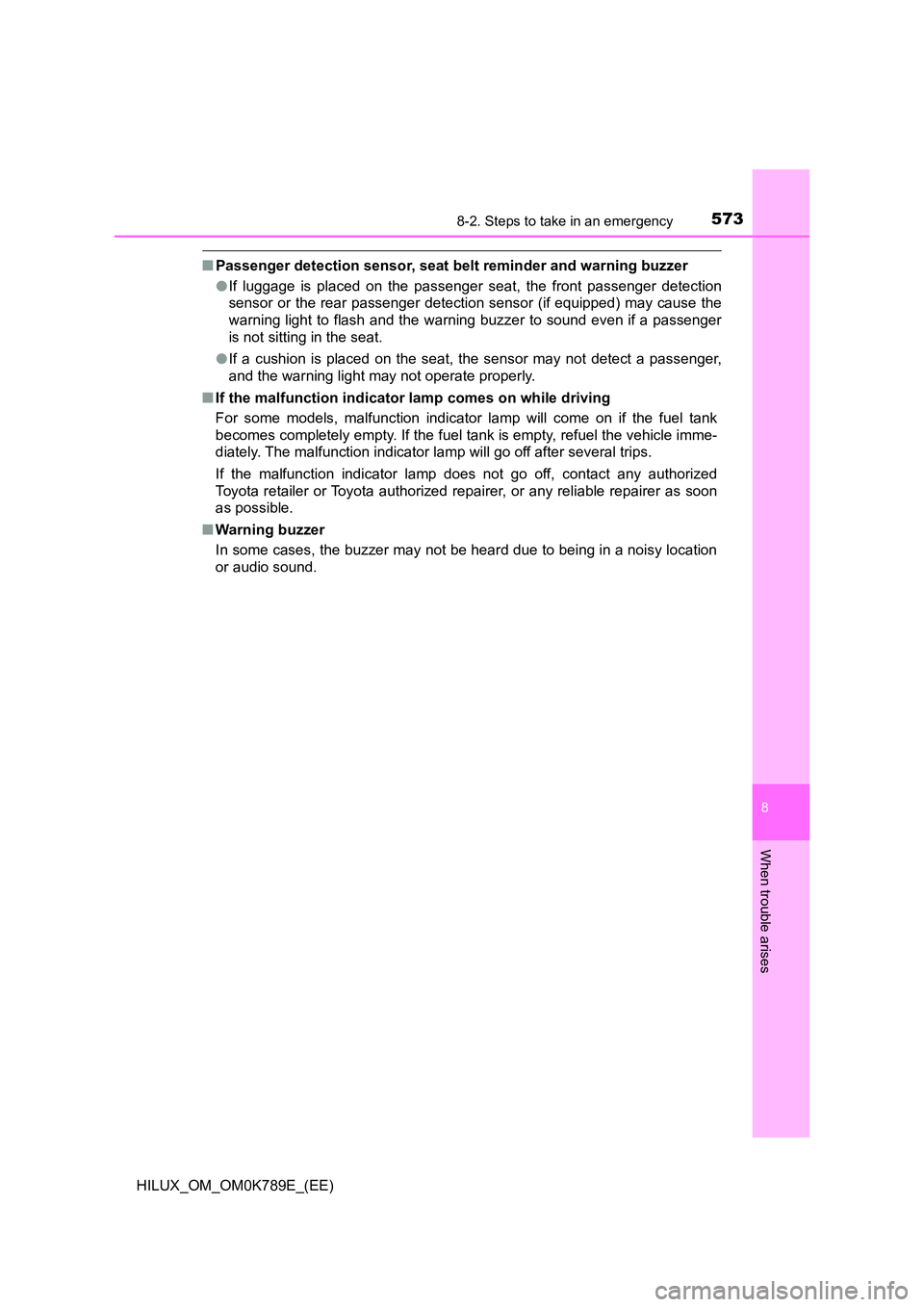
5738-2. Steps to take in an emergency
HILUX_OM_OM0K789E_(EE)
8
When trouble arises
■Passenger detection sensor, seat belt reminder and warning buzzer
● If luggage is placed on the passenger seat, the front passenger detection
sensor or the rear passenger detecti on sensor (if equipped) may cause the
warning light to flash and the warning buzzer to sound even if a passenger
is not sitting in the seat.
● If a cushion is placed on the seat, the sensor may not detect a passenger,
and the warning light may not operate properly.
■ If the malfunction indicator lamp comes on while driving
For some models, malfunction indicator lamp will come on if the fuel tank
becomes completely empty. If the fuel tank is empty, refuel the vehicle imme-
diately. The malfunction indicator lamp will go off after several trips.
If the malfunction indicator lamp does not go off, contact any authorized
Toyota retailer or Toyota authorized repai rer, or any reliable repairer as soon
as possible.
■ Warning buzzer
In some cases, the buzzer may not be heard due to being in a noisy location
or audio sound.